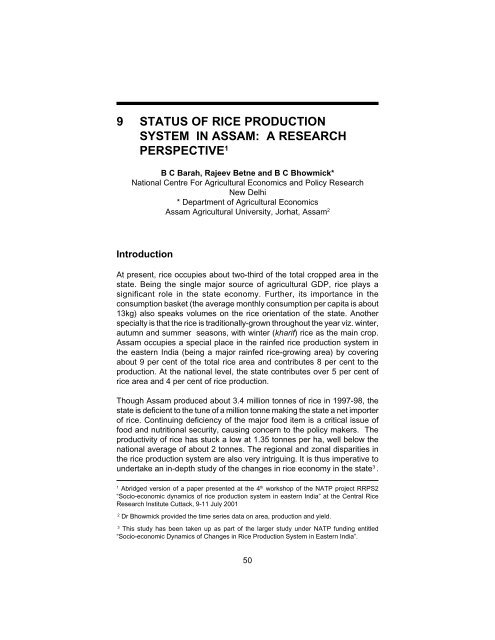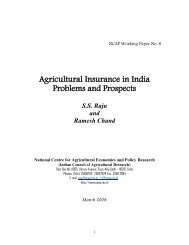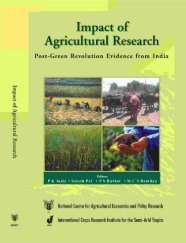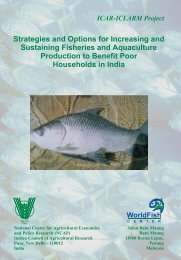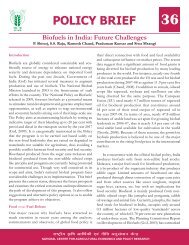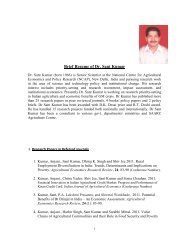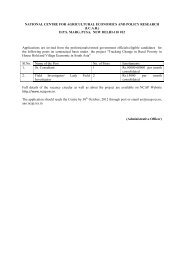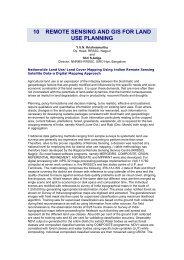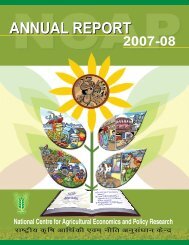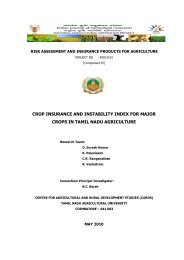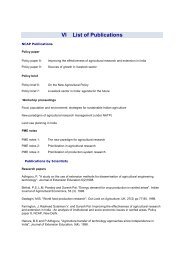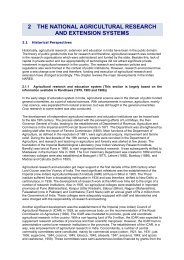9 status of rice production system in assam: a research ... - NCAP
9 status of rice production system in assam: a research ... - NCAP
9 status of rice production system in assam: a research ... - NCAP
You also want an ePaper? Increase the reach of your titles
YUMPU automatically turns print PDFs into web optimized ePapers that Google loves.
The objectives <strong>of</strong> the paper are to understand the evolution <strong>of</strong> <strong>rice</strong> <strong>production</strong><strong>system</strong> s<strong>in</strong>ce <strong>in</strong>dependence, exam<strong>in</strong>e the modern technological scenario<strong>in</strong> different agro-eco<strong>system</strong>s, test the hypothesis <strong>of</strong> <strong>in</strong>ter-zonal disparities<strong>of</strong> performance <strong>of</strong> <strong>rice</strong> technology and to identify the policy <strong>in</strong>terventions <strong>in</strong>agriculture.The relevant data from secondary sources have been utilized <strong>in</strong> the presentstudy. Various publications and issues <strong>of</strong> Directorate <strong>of</strong> Economics andStatistics, Government <strong>of</strong> Assam and Government <strong>of</strong> India, CMIE, M<strong>in</strong>istry<strong>of</strong> Rural Areas and Employment and CRRI, Cuttack have been majorsources <strong>of</strong> secondary data.This paper has been broadly divided <strong>in</strong>to two sections. The first sectionprovides the trends, growth and <strong>in</strong>stability, cropp<strong>in</strong>g pattern, the <strong>status</strong> <strong>of</strong>improved technology, yield gaps, risk <strong>in</strong> <strong>rice</strong> and <strong>rice</strong> <strong>research</strong> at the statelevel. The second section presents the disaggregate analysis <strong>of</strong> agroclimaticzones. The zonal analysis is carried out based on orig<strong>in</strong>al undivided10 districts <strong>of</strong> the state. The disaggregate analysis conta<strong>in</strong>s the share <strong>of</strong><strong>rice</strong> by seasons, growth and stability and performance based rank<strong>in</strong>g <strong>of</strong>the zones. An Agricultural Development Index (ADI)’ is calculated us<strong>in</strong>gn<strong>in</strong>e <strong>in</strong>dicators namely, credit, irrigation, HYV area, fertilizer consumption,road length, rural literacy, labour availability, labour productivity and <strong>in</strong>fantmortality and regressed with <strong>rice</strong> yield across the seasons. The factors areaggregated <strong>in</strong>to the <strong>in</strong>dex for each <strong>of</strong> the zones as a unify<strong>in</strong>g measure tosimplify the analysis. The <strong>in</strong>dices (FI) <strong>of</strong> the <strong>in</strong>dividual factors are aggregated<strong>in</strong>to ADI. The follow<strong>in</strong>g formula is considered for the construction <strong>of</strong> the<strong>in</strong>dex.(Value <strong>of</strong> factor for a zone-m<strong>in</strong>imum value <strong>of</strong> factor over all zones)FI = –——————————————————————————————–Range <strong>of</strong> values <strong>of</strong> the factorADI = Σ FI) X N / 100, where N = number <strong>of</strong> factorsThe State Pr<strong>of</strong>ileTrends through 1950s: Dur<strong>in</strong>g fifty years s<strong>in</strong>ce <strong>in</strong>dependence, the areaunder <strong>rice</strong> <strong>in</strong>creased by about 64 per cent, while the <strong>production</strong> has morethan doubled register<strong>in</strong>g about 116 per cent growth, ma<strong>in</strong>ly on account <strong>of</strong>area expansion. The l<strong>in</strong>ear growth rate <strong>of</strong> productivity is barely 38 per centdur<strong>in</strong>g this long period, which is quite low. W<strong>in</strong>ter (kharif) <strong>rice</strong> dom<strong>in</strong>ates <strong>in</strong>both area and <strong>production</strong>, followed by autumn (pre-kharif) <strong>rice</strong> and summer(rabi) <strong>rice</strong>. But, the share <strong>of</strong> w<strong>in</strong>ter <strong>rice</strong> decl<strong>in</strong>ed from 78 per cent <strong>in</strong> 1952 to66 per cent <strong>in</strong> 1999, though the absolute area shows an <strong>in</strong>crement <strong>of</strong> abouthalf a million ha. The area share <strong>of</strong> autumn <strong>rice</strong> rema<strong>in</strong>ed constant whilethe summer crop has shown a quantum jump <strong>in</strong> growth from merely 0.2751
per cent <strong>in</strong> 1952 to 10 per cent <strong>in</strong> 1999. Summer <strong>rice</strong> performedoutstand<strong>in</strong>gly <strong>in</strong> the last decade, record<strong>in</strong>g over two-fold <strong>in</strong>crease <strong>in</strong>productivity level. The <strong>in</strong>cremental productivity <strong>of</strong> autumn and w<strong>in</strong>ter <strong>rice</strong>dur<strong>in</strong>g the last four decades ranges from 220 to 420 kilogram per harespectively. The yield <strong>of</strong> summer <strong>rice</strong> is march<strong>in</strong>g close to the nationalaverage at 1.99 tonnes. Should not the state adopt appropriate strategy toenhance the yield <strong>of</strong> w<strong>in</strong>ter paddy at least to the level <strong>of</strong> national average?This is also a <strong>research</strong> challenge to crop scientists to develop requiredtechnology for the purpose.Growth and InstabilityThe growth <strong>in</strong> agricultural <strong>production</strong> is essential for any economy,particularly <strong>in</strong> an agrarian economy where the food demand overstrips thesupply due to population growth. In Assam, <strong>rice</strong> has been the major food <strong>in</strong>the consumption basket. However, the growth scenario <strong>of</strong> <strong>rice</strong> <strong>in</strong> the statehas been quite unsatisfactory. Consider<strong>in</strong>g the unparallel population growth<strong>in</strong> the state, the matter requires greater attention. Figure1 clearly <strong>in</strong>dicatesthe fact that the state has by and large fallen <strong>in</strong> a situation <strong>of</strong> ‘food trap’ <strong>in</strong>the post-<strong>in</strong>dependent period where the growth <strong>in</strong> consumption demand <strong>of</strong><strong>rice</strong> persistently exceeds the <strong>production</strong> growth for a longer period. Theresult, once a surplus state has become a net importer <strong>of</strong> <strong>rice</strong> from theearly 1970s. Though there have been some achievements <strong>in</strong> the <strong>production</strong>,especially <strong>in</strong> the 1980s, the process aga<strong>in</strong> has weakened <strong>in</strong> the early 1990s.In this circumstance, the state must <strong>in</strong>tervene by <strong>in</strong>vest<strong>in</strong>g heavily on thestrategic <strong>research</strong> on newer <strong>production</strong> frontiers so as to breakthrough theshackles <strong>of</strong> the yield barrier. Improved varieties, timely availability <strong>of</strong> seeds,<strong>in</strong>frastructural support <strong>system</strong> viz; irrigation, roads, electricity, market etc.,mechanization, <strong>in</strong>tegrated nutrient management and speedy extension <strong>of</strong>technical knowhow hold the key to future growth pathway. The future policyshould follow an <strong>in</strong>tegrated approach rather than <strong>of</strong>ten followed piecemealapproach.Between 1952 and 1992, the total <strong>rice</strong> area <strong>in</strong>creased steadily reach<strong>in</strong>g aplateau at 2.55 million ha and thereafter slumped to negative growth ma<strong>in</strong>lybecause <strong>of</strong> decl<strong>in</strong>e <strong>of</strong> w<strong>in</strong>ter <strong>rice</strong> area. It has resulted <strong>in</strong> decl<strong>in</strong>e <strong>of</strong> absolute<strong>rice</strong> area <strong>in</strong> the recent years. The path <strong>of</strong> growth <strong>of</strong> <strong>rice</strong> yield has beenhighly uneven <strong>in</strong> the state (Figure 2). Until the mid-1970s, the yield wasstagnant at low level. The scenario has changed to positive growth <strong>in</strong> thesubsequent period, which reached the peak <strong>of</strong> 1.31 per cent per annumdur<strong>in</strong>g the 1980s. The growth rate <strong>of</strong> yield <strong>of</strong> summer <strong>rice</strong> however, is at animpressive rate <strong>of</strong> over 4 per cent per annum as compared to that <strong>of</strong> thew<strong>in</strong>ter <strong>rice</strong> yield at 1.36 per cent per annum. More adoption <strong>of</strong> high-yield<strong>in</strong>gvarieties, expansion <strong>of</strong> irrigation and a rapid shift <strong>in</strong> summer cultivationpractices has improved the performance <strong>of</strong> summer and w<strong>in</strong>ter <strong>rice</strong>. But,52
this growth pattern could not be susta<strong>in</strong>ed <strong>in</strong> the 1990s. Fewer technologicaloptions and <strong>in</strong>adequate <strong>in</strong>frastructure support affected the recentperformance. The <strong>production</strong> growth followed the similar pattern as that <strong>of</strong>yield. However, the slow down <strong>of</strong> yield growth coupled with negative growth<strong>in</strong> area resulted <strong>in</strong> decl<strong>in</strong><strong>in</strong>g rate <strong>of</strong> <strong>production</strong> dur<strong>in</strong>g 1990s. The variability<strong>of</strong> <strong>rice</strong> area, <strong>production</strong> and yield <strong>in</strong> the state has been moderately low.Coefficients <strong>of</strong> variation dur<strong>in</strong>g the fifty years have rema<strong>in</strong>ed quite lowrang<strong>in</strong>g from 0.03 per cent to 6.26 per cent annually (Figure 3). The highestvariability was observed <strong>in</strong> <strong>production</strong> dur<strong>in</strong>g 1960s due to rapid <strong>in</strong>crease<strong>in</strong> the <strong>rice</strong> area and uneven yield trends. The phenomenon <strong>of</strong> stability atlow level <strong>of</strong> <strong>rice</strong> <strong>production</strong> <strong>in</strong> the state is clear <strong>in</strong>dication <strong>of</strong> stagnation. Infact, the low variability, though a desirable trait, when coupled with lowlevel <strong>of</strong> productivity, symbolizes a sluggish nature <strong>of</strong> the performance <strong>of</strong><strong>rice</strong> <strong>in</strong> the state. Why does the low-level yield barrier rema<strong>in</strong>ed unbroken <strong>in</strong>the state, is another critical question?Compound grow4.00Rice Demand3.002.001.00Rice <strong>production</strong>0.0050s 60s 70s 80s 90sDecadeFig. 1 : Good trap <strong>in</strong> AssamCompound GrowProduction2.502.001.501.00Yield0.50Area0.00-0.5050s 60s 70s 80s 90s-1.00DecadeFig. 2 : Growth scenario <strong>of</strong> <strong>rice</strong> <strong>in</strong> Assam53
times [<strong>in</strong> the latest list <strong>of</strong> centrally released varieties for the states, novarieties are earmarked for the state <strong>of</strong> Assam (ICAR Annual Report 2000-2001)]. The non-availability <strong>of</strong> seeds <strong>of</strong> recommended varieties is anotherperennial problem.Although, the government <strong>in</strong>vested to some extent on <strong>research</strong> on varietalimprovement <strong>in</strong> Assam <strong>in</strong> the earlier period, but now it must <strong>in</strong>vest more onR&D programmes <strong>in</strong> agriculture. The eco<strong>system</strong>s such as lowland, deepwaterhave been practically ignored <strong>in</strong> the exist<strong>in</strong>g varietal developmentprogramme. The deep-water <strong>rice</strong> (locally called as Boa) is important <strong>in</strong>many pockets <strong>of</strong> Brahmaputra valley, thus improvisation <strong>of</strong> the <strong>production</strong>condition <strong>in</strong> this large-sized eco<strong>system</strong> is <strong>of</strong> urgent need. Most exist<strong>in</strong>gvarieties are <strong>of</strong> long-duration and a very few are resistant to pests anddiseases. Also only few modern varieties have the tolerance capacity tosubmergence. This is a serious issue consider<strong>in</strong>g the fact that most part <strong>of</strong>the state is ravaged by splashes <strong>of</strong> flood on a regular basis. Increasedcultivation <strong>of</strong> boro paddy <strong>in</strong> rabi season could be potentially revolutionary,which is steadily spread<strong>in</strong>g <strong>in</strong> the areas <strong>of</strong> assured irrigation. But thetechnological <strong>in</strong>novation for boro <strong>rice</strong> <strong>system</strong> needs to be followed with<strong>in</strong>creased emphasis. The majority <strong>of</strong> the exist<strong>in</strong>g modern varieties aresuitable only for kharif (w<strong>in</strong>ter <strong>rice</strong>) and pre-kharif (autumn) seasons. Thereis also need for more short-duration <strong>rice</strong> varieties so as to escape excessivera<strong>in</strong> dur<strong>in</strong>g maturity and/or harvest<strong>in</strong>g <strong>of</strong> the crop.Table 1: Varietal <strong>status</strong> <strong>of</strong> <strong>rice</strong> <strong>in</strong> AssamVarieties suitable for No. <strong>of</strong> Resistance Average Grownvarieties to pests and duration asdiseasesShallow water 12 Poor 153 Kharif <strong>rice</strong>Eco-<strong>system</strong>Irrigated eco-<strong>system</strong> 9 Poor 131 Pre-kharif <strong>rice</strong>Upland eco-<strong>system</strong> 1 Poor 100 Pre-kharif <strong>rice</strong>Boro (Rabi) cultivation 4 NA 160 Rabi <strong>rice</strong>Source: Miracle <strong>rice</strong>, CRRI, 1995 and B. N S<strong>in</strong>gh 2001Increas<strong>in</strong>g yield as well as yield-gapsIncreas<strong>in</strong>g the yield potential <strong>of</strong> staple crops has been one <strong>of</strong> the criticalchallenges to the agricultural <strong>research</strong> scientists. The biological scientistshave put-forth their valuable efforts <strong>in</strong> enhanc<strong>in</strong>g the yield potential <strong>of</strong> <strong>rice</strong><strong>in</strong> the state to around 5 tons per ha. (<strong>in</strong> term <strong>of</strong> rough <strong>rice</strong>), nonetheless,the growth <strong>in</strong> biological yield potential is also stagnat<strong>in</strong>g dur<strong>in</strong>g the last55
decade (Figure 5). Bridg<strong>in</strong>g the gap between the biological potential andactual yield <strong>in</strong> one go is an unhill task, but an effort must be made <strong>in</strong> thisdirection. A success <strong>in</strong> the effort will contribute at least an additional tonne<strong>of</strong> paddy per hectare <strong>in</strong> the state. Here the extension services would play avery important role for the success <strong>of</strong> the technology. Of course, for therealization <strong>of</strong> the on-farm experimental yield, a number <strong>of</strong> <strong>in</strong>terventions areneeded particularly <strong>in</strong> the doma<strong>in</strong> <strong>of</strong> <strong>in</strong>put supply and other delivery <strong>system</strong>.Interest<strong>in</strong>gly, although the <strong>rice</strong> yield is <strong>in</strong>creas<strong>in</strong>g gradually, the gap betweenstate average and the national level is also rapidly <strong>in</strong>creas<strong>in</strong>g pos<strong>in</strong>g aserious future policy challenge (Figure 4). Over the years, the gorge betweenaverage <strong>rice</strong> yield <strong>in</strong> Assam and India/ rest <strong>of</strong> India has <strong>in</strong>creased fromabout 70 kg/ ha <strong>in</strong> 1970 to over 600 kg/ha <strong>in</strong> 2000. Increas<strong>in</strong>g gaps alsoco<strong>in</strong>cide with the poverty situation <strong>in</strong> the region. Apparently, there is highcorrelation between the yield gap and the poverty level (Plann<strong>in</strong>gCommission 2000). Should the technological solution be <strong>in</strong>tegrated withthe socio-economic dimnsion <strong>of</strong> the problem? An <strong>in</strong>trospection is essentialon the choice <strong>of</strong> right technology <strong>in</strong> the region. Investments <strong>in</strong> the areas <strong>of</strong><strong>in</strong>frastructure development and <strong>in</strong>put market<strong>in</strong>g would be <strong>of</strong> great help torevitalize a non-starter green revolution. More <strong>research</strong> on socio-economic<strong>research</strong> would be useful to thoroughly diagnose the cause-effectrelationship and advocate suitable policy measures to overcome this lag.A ssam & IndiaA ssam & re s t <strong>of</strong> India700600500Kg/ ha 4003002001000-100707376798285889194970Fig. 4 : Inflat<strong>in</strong>g yield gaps <strong>in</strong> <strong>rice</strong> (Assam Vs India/ rest <strong>of</strong> India)Rice and riskHigh risk <strong>of</strong> flood, low and static yield characterize the <strong>rice</strong> <strong>production</strong> <strong>system</strong><strong>in</strong> Assam. Accord<strong>in</strong>g to an estimate about 2.41 lakh ha <strong>of</strong> <strong>rice</strong> fields arechronically affected by the floods and about a lakh ha are occasionallyflood affected (Table 2). Moreover, large area under the stand<strong>in</strong>g crop56
500045004000350030002500Kg/H aT ria lA verage20001500M a x A tta <strong>in</strong> e d1000500A c tu a l075909599Fig. 5: The potential, actual and maximum farm yield <strong>of</strong> <strong>rice</strong> <strong>in</strong> Assamquite <strong>of</strong>ten faces varied degree <strong>of</strong> submergence. Heavy ra<strong>in</strong>s dur<strong>in</strong>g Mayto August cause flood<strong>in</strong>g and affect<strong>in</strong>g the w<strong>in</strong>ter <strong>rice</strong> is adversely <strong>in</strong> theprocess. More <strong>of</strong>ten, the flood wave co<strong>in</strong>cides with the matur<strong>in</strong>g and/orharvest<strong>in</strong>g period <strong>of</strong> summer and autumn <strong>rice</strong> <strong>in</strong> many areas and washaway valuable output. This has an adverse impact on the farm <strong>in</strong>come andmore importantly on the household food security.The undependable <strong>in</strong>put supply and fluctuat<strong>in</strong>g area under HYV add to therisk <strong>in</strong> the state. The Boro is an <strong>in</strong>put, <strong>in</strong>tensive crop, where timely irrigation<strong>in</strong>fluences the yield pattern. With about 10 per cent <strong>of</strong> <strong>rice</strong> area underirrigation <strong>in</strong> the state, the yield <strong>of</strong> Boro <strong>rice</strong> will be constra<strong>in</strong>ed severely.This also limits the adoption <strong>of</strong> HYV at about half <strong>of</strong> the total <strong>rice</strong> area <strong>in</strong> thestate. Installation <strong>of</strong> shallow tubewells <strong>in</strong> the recent years has facilitatedthe summer <strong>rice</strong> <strong>in</strong> limited areas, which needs expansion. Provid<strong>in</strong>g assured<strong>in</strong>put supply, could <strong>in</strong>crease <strong>in</strong> the adoption rate <strong>of</strong> HYV and likely to reduceTable 2: Estimates <strong>of</strong> flood-prone area <strong>of</strong> Assam (‘000 ha)Agroclimatic zones Net Chronica- Occasiona Total % tocropped lly flood- lly flood- flood- netarea prone Area prone prone croppedarea area areaNorth bank Pla<strong>in</strong> 470 93 40 133 28Upper Brahmaputra Valley 480 45 16 61 13Central Brahmaputra Valley 295 16 8 24 8Lower Brahmaputra Valley 920 92 17 109 12Barak Valley 247 4 10 14 6Assam Total 2412 250 91 341 14Source: Hydrology and Groundwater Resource Development (1980)Note: The figures are the averages <strong>of</strong> 1968 through 197857
variability and risk <strong>of</strong> <strong>production</strong>. Hazell (1982) suggested that the <strong>in</strong>creasedvariability <strong>in</strong> the <strong>production</strong> is not due to adoption <strong>of</strong> HYVs per se but anoutcome <strong>of</strong> <strong>in</strong>stability <strong>in</strong> the <strong>in</strong>put supply.In addition, development <strong>of</strong> <strong>rice</strong> varieties with stress tolerance capabilitiesto biotic and abiotic pressure must be taken up on priority basis. Aparticipatory policy environment by <strong>in</strong>volv<strong>in</strong>g the local masses <strong>in</strong>conservation <strong>of</strong> ra<strong>in</strong>water is necessary for efficient utilization <strong>of</strong> waterresource. Ex-ante strategies such as share cropp<strong>in</strong>g, crop diversification,staggered plant<strong>in</strong>g for flood escape, <strong>in</strong>come generation through <strong>of</strong>f-farmemployment and other self adjustment mechanism need to be popularized<strong>in</strong> the state. This requires long-term perspective plan to handle risk aris<strong>in</strong>gdue to multifarious factors.Rice <strong>research</strong> <strong>in</strong> AssamRice <strong>research</strong> <strong>in</strong> India has been highly reward<strong>in</strong>g, generat<strong>in</strong>g returns closeto 30-50% (Jha and Kumar 1999). But, the agricultural <strong>research</strong> <strong>in</strong> easternIndia requires particular emphasis on boost<strong>in</strong>g <strong>research</strong> and developmentefforts for ra<strong>in</strong>fed (upland and lowland) <strong>rice</strong> <strong>research</strong> <strong>system</strong>.The basic <strong>rice</strong> <strong>research</strong> <strong>in</strong> the state, though far from adequate, has mostlybeen conf<strong>in</strong>ed to the varietal development and improvement. Very littleattention has been paid to the crucial areas such as susta<strong>in</strong>ability,eco<strong>system</strong> <strong>research</strong>, efficiency, market<strong>in</strong>g etc. There are few micro-levelcase studies at the village level or at the block level and fewer at the districtlevel. These case studies generally perta<strong>in</strong> to farmers’ adoption behaviour,gender, energy use pattern and impact assessment. The case studies areimportant for improv<strong>in</strong>g the <strong>production</strong> environment at the local level buthardly capable to address broader policy issues at the regional level.Studies at the zonal or regional level, based on homogenous agroeco<strong>system</strong>s,are very limited. Further, <strong>research</strong> <strong>in</strong> other frontier areas suchas credit, constra<strong>in</strong>ts, risk management, crop diversification, efficiency,market<strong>in</strong>g and trade, export and socio-economics are necessary. These<strong>research</strong> areas are critical to Assam <strong>in</strong> the context <strong>of</strong> fast chang<strong>in</strong>g globalagricultural order.Analysis by Agroclimatic Zones 4Inter-zonal pattern <strong>of</strong> <strong>rice</strong> <strong>production</strong>: Assam is divided <strong>in</strong>to sixagroclimatic NARP zones compris<strong>in</strong>g <strong>of</strong> ten orig<strong>in</strong>al districts (Map 1 andTable 3). The Lower Brahmaputra Valley Zone (LBVZ) contributes maximumto the total <strong>rice</strong> area and <strong>production</strong> <strong>in</strong> the state while hill zone (HZ) the4This section considers the classification based on NARP report (1991). The section considersonly ten (10) orig<strong>in</strong>al districts <strong>of</strong> the state.58
Legends1. Barak Valley Zone2. Hill Zone3. Central Brahmaputra ValleyZone4. Upper Brahmaputra ValleyZone5. North-bank Pla<strong>in</strong> Zone LowerBrahmaputra Valley ZoneMap 1 : Assam by Agro-climatic zones (map not to scale)least. However, the productivity <strong>of</strong> <strong>rice</strong> is the least <strong>in</strong> LBVZ. The productivityis satisfactory <strong>in</strong> the BVZ, UBVZ and <strong>in</strong> CBVZ <strong>in</strong> the order <strong>of</strong> magnitude.Table 3: Zone-wise share <strong>of</strong> geographical area, <strong>rice</strong> area and<strong>production</strong> (1998-99)Agro- Geographi- Rice Rice Rice Rice Riceclimatic cal area as area (ha) <strong>production</strong> area as <strong>production</strong> yieldzones % <strong>of</strong> state (ton) % <strong>of</strong> total as % <strong>of</strong> (kg/ha)area <strong>rice</strong> area total <strong>rice</strong><strong>production</strong>UBVZ 21 403512 660398 16 20 1636Hill Zone 20 123744 173860 5 5 1404NBPZ 18 454487 521369 19 16 1147LBVZ 26 900048 959017 37 29 1065BVZ 8 220294 386163 9 12 1752CBVZ 7 352037 554025 14 17 1573Assam 100 2454122 3254832 100 100 1326Higher adoption <strong>of</strong> HYV and irrigated area under <strong>rice</strong> and higher fertilizerapplication per unit area are contribut<strong>in</strong>g to the higher productivity. Higheracreage under summer <strong>rice</strong> is also a contribut<strong>in</strong>g factor. In case <strong>of</strong> LBVZand NBPZ, frequent occurrence <strong>of</strong> flood is hamper<strong>in</strong>g their performancepattern. The effect <strong>of</strong> the critical <strong>in</strong>teraction among the factors is alsoresponsible for the <strong>in</strong>ter-zonal disparities. By rais<strong>in</strong>g the productivity levelcloser to the state average <strong>in</strong> these two zones (NBPZ and LBVZ), anadditional 3 lakh tonnes <strong>of</strong> <strong>rice</strong> could be produced, which would potentiallyreduce the food deficit by over 30 per cent. Given the present resourceendowment <strong>of</strong> the zones, this option can easily be adopted if necessarypolicy supports are provided. Improv<strong>in</strong>g utilization <strong>of</strong> rabi fallow could alsobe a necessary policy thrust.59
Table 4: Zone-wise and season-wise distribution <strong>of</strong> <strong>rice</strong> <strong>in</strong> AssamAgro- Autumn W<strong>in</strong>ter Summer 1999 yield (t/ha)climaticzones 89 99 89 99 89 99Autu- W<strong>in</strong> SumA P A P A P A P A P A Pmn ter merHZ 3 3 3 4 6 6 7 7 1 0 1 1 1.2 1.5 1.8UBVZ 8 12 6 9 22 25 22 26 0 0 3 3 1.6 1.6 1.8NBPZ 22 22 22 21 20 20 20 18 4 4 11 10 0.9 1.4 1.3BVZ 5 11 3 7 10 12 11 13 23 23 7 6 1.8 1.6 1.4LBVZ 48 37 52 43 31 26 30 25 42 38 38 34 0.8 1.2 1.6CBVZ 14 15 14 16 11 11 10 11 30 35 40 46 1.2 1.4 2.3Assam 100 100 100 100 100 100 100 100 100 100 100 100 0.9 1.4 1.99Note: A- area, P- Production60
The share <strong>of</strong> <strong>rice</strong> area <strong>in</strong> the lower Brahmaputra zone is the highest, thoughit decreased <strong>in</strong> w<strong>in</strong>ter and summer <strong>in</strong> the period 1989 to 1999 (Table 4).There is not much change <strong>in</strong> the seasonal share <strong>in</strong> other zones. But, <strong>in</strong>case <strong>of</strong> summer crop, there are marked changes <strong>in</strong> the all the zones, exceptBVZ. Despite the fact that on an average about 17.0 thousand ha hasbeen put under summer <strong>rice</strong> <strong>in</strong> the BVZ annually and significantly highproportion <strong>of</strong> area under summer <strong>rice</strong> <strong>in</strong> NBPZ, the performance <strong>of</strong> BVZand NBPZ has not improved. The static productivity is once aga<strong>in</strong> the limit<strong>in</strong>gfactor <strong>in</strong> the zones. The figures 6 and 7 show zonal pattern <strong>of</strong> changes <strong>in</strong>the area.Growth PerformancesBarr<strong>in</strong>g a few exceptions, the growth performance <strong>of</strong> various zones <strong>in</strong> thelast five decades has been identical to that <strong>of</strong> the state. Until 1970s therate <strong>of</strong> growth <strong>in</strong> the <strong>rice</strong> area was impressive <strong>in</strong> all the zones except <strong>in</strong>NBPZ where the growth rates started <strong>in</strong>creas<strong>in</strong>g after 1970s (figure 10 &11). Dur<strong>in</strong>g 1990s, the growth <strong>of</strong> area showed decl<strong>in</strong><strong>in</strong>g trends and <strong>in</strong> somecases crossed the horizontal axis (i.e. negative growth). On the contrary,the growth rates <strong>of</strong> yield showed improvement dur<strong>in</strong>g and after 1980s(Figure 8 & 9). Hill zone is aga<strong>in</strong> the exception, which has registered highestgrowth <strong>in</strong> yield dur<strong>in</strong>g 1960s and is the only region that looks promis<strong>in</strong>gdur<strong>in</strong>g 1990s. However, on the whole, the yield growth seems to stagnatearound 1.5 per cent <strong>in</strong> most <strong>of</strong> these zones. This endorses the generalperception that green revolution has bypassed the state even at the zonallevel. The decadal growth performance has been uneven and associatedwith substantial variability. The variability is much higher <strong>in</strong> case <strong>of</strong> summercrop as the crop is highly dependent on the <strong>in</strong>put availability. As already<strong>in</strong>dicated earlier, many factor <strong>in</strong>teractions are responsible for the <strong>in</strong>ter-zonaldisparities <strong>in</strong> the performance. It is observed that the simplified <strong>in</strong>dex 5 form( termed as agricultural development <strong>in</strong>dex ADI) provides a fair idea <strong>of</strong> theprobable causes <strong>of</strong> the diverse performance <strong>of</strong> the zones. The rank<strong>in</strong>g <strong>of</strong>the zone based on the <strong>in</strong>dex shows, as expected, that the flood-pronezones are highly disadvantaged and ranked the lowest, where yield is thelowest. Figure 16 to 18 sketches the simple relationship between the ADIand yield <strong>in</strong> six agro-climatic zones <strong>in</strong> Assam by season. A closer look atthe factor <strong>in</strong>teraction at disaggregate level is needed to understand thecausality <strong>of</strong> the disparities.Conclusion and Policy IssuesThe <strong>rice</strong> has a historical significance and cultural relevance <strong>in</strong> the state <strong>of</strong>Assam, apart from be<strong>in</strong>g the staple food. Despite its importance <strong>in</strong> every5k<strong>in</strong>dly refer back to Data and Methodology section61
sphere <strong>of</strong> the agrarian economy, the performance <strong>of</strong> crop <strong>in</strong> the recentyears has been unsatisfactory, which made Assam a net deficit state. Thegreen revolution totally bypassed the state <strong>in</strong> the past, although somespillover effect may be seen dur<strong>in</strong>g and after mid-1980s. The poorperformance is caused by lack <strong>of</strong> required <strong>in</strong>frastructure support <strong>system</strong>and policy environment. The average yield <strong>of</strong> <strong>rice</strong> stands well below thenational average. The growth path has been uneven and perpetuat<strong>in</strong>g thepeculiar phenomenon <strong>of</strong> stability at low level <strong>of</strong> <strong>production</strong> trap, which isrequired to be elim<strong>in</strong>ated. The sluggish growth <strong>of</strong> the crop is the result <strong>of</strong><strong>production</strong> trap. The supply <strong>of</strong> technology, <strong>in</strong>frastructure, material <strong>in</strong>putsare the important govern<strong>in</strong>g factors for the betterment <strong>of</strong> <strong>rice</strong> <strong>production</strong><strong>system</strong>, which are grossly <strong>in</strong>adequate at present. However, the sign <strong>of</strong><strong>in</strong>novativeness <strong>of</strong> the farmers has been noteworthy, especially <strong>in</strong> the recentdecade. The rapid expansion <strong>of</strong> high potential Boro cultivation <strong>of</strong> <strong>rice</strong> <strong>in</strong> therabi season is a sign <strong>of</strong> improvement <strong>in</strong> the situation. Nonetheless, theyhave to be adequately nurtured through suitable <strong>in</strong>put supply and betterpolicy environment. The calculation shows that by enhanc<strong>in</strong>g the presentlevel <strong>of</strong> productivity to the national average level, the state can produce atleast a tonne <strong>of</strong> additional <strong>rice</strong> annually. The neglected zones like BVZ andNBVZ together can produce about 30 thousand tonnes <strong>of</strong> <strong>rice</strong>, if theproductivity is enhanced.There are disparities <strong>in</strong> the performance among the agro-climatic zones <strong>in</strong>the state. Broadly on account <strong>of</strong> the <strong>in</strong>teraction effect among socio-economicand agro-biological factors has caused the uneven performance over thezones, which is rarely understood. That is why, the region with larger share<strong>of</strong> <strong>rice</strong> area and <strong>production</strong> such as LBVZ, is show<strong>in</strong>g dismal yieldperformance. Noticeably, the performance <strong>of</strong> the summer <strong>rice</strong> (boro) hasalso been uneven <strong>in</strong> all the zones and no def<strong>in</strong>ite pattern <strong>of</strong> growth isobserved, probably due to its high dependency on the <strong>in</strong>put availability,especially irrigation.The results <strong>of</strong> the study suggest greater emphasis on the <strong>research</strong> anddevelopment <strong>in</strong>itiatives, specifically on socio-economic and policy <strong>research</strong>.For the purpose <strong>of</strong> enhanc<strong>in</strong>g future growth, strengthen<strong>in</strong>g the <strong>in</strong>formation<strong>system</strong> and development <strong>of</strong> comprehensive database at the disagregateeco<strong>system</strong> level is highly recommended. Though there has been stagnation<strong>in</strong> the biological potential <strong>in</strong> <strong>rice</strong>, there still exists large yield gap <strong>of</strong> variousdegrees. Steady <strong>in</strong>put supply and improv<strong>in</strong>g the knowledge dissem<strong>in</strong>ationservice <strong>in</strong> the state would def<strong>in</strong>itely help <strong>in</strong> bridg<strong>in</strong>g the gaps. The practice<strong>of</strong> cultivation <strong>of</strong> boro <strong>rice</strong> is <strong>in</strong> a budd<strong>in</strong>g stage <strong>in</strong> the state that needs to benurtured through adequate irrigation network and more technologicalsupport. This would help ga<strong>in</strong>fully utilize the vast tract <strong>of</strong> rabi fallow andimprove cropp<strong>in</strong>g <strong>in</strong>tensity. Reforms on the weaker <strong>in</strong>put-output delivery<strong>system</strong> is also required for effective promotion <strong>of</strong> the <strong>system</strong>.62
100.0090.0080.0070.0060.0050.0040.0030.0020.0010.00AutumnW<strong>in</strong>tersummer0.00HZ UBVZ NBPZ BVZ LBVZ CBVZFig. 6: Intra-zonal seasonal share (%) <strong>of</strong> <strong>rice</strong> area (1989 and 1999)100.0090.0080.0070.0060.0050.0040.0030.0020.0010.000.00AutumnW<strong>in</strong>terSummerHZ UBV Z NBPZ BV Z LBV Z CBV ZFig. 7: Intra-zonal seasonal share (%) <strong>of</strong> <strong>rice</strong> <strong>production</strong> (1989 and 1999)63
6.006ub5.00CGR 4.003.002.00nbhz1.000.001.0050S 60S 70S 80S 90S2.00Decade4.003.002.00bvcblbCGR1.000.0050S1.0060S 70S 80S 90S2.00DecadeFig. 8 & 9 : Zone-wise total yield growth pattern <strong>in</strong> AssamCGR10.008.006.004.00nbubhz82.000.0050S2.0060S 70S 80S 90SDecade4.003.00lbcb9bvCGR2.001.000.0050S 60S 70S 80S 90S1.00DecadeFig. 10 &11 : Zone-wise growth pattern <strong>of</strong> <strong>rice</strong> area <strong>in</strong> Assam64
20.0015.00hz10CV10.00nbub5.000.00Decade50S 60S 70S 80S 90SCV14.001112.00bv10.008.006.00cb4.002.00lb0.0050S 60S 70S 80S 90SDecadeFig. 12 & 13 : Zone-wise variability <strong>in</strong> total <strong>rice</strong> yield <strong>in</strong> Assam30.0025.0020.00ubhz12CV15.0010.00nb5.000.0050SDecade60S 70S 80S 90SCV1216.0014.00lb12.0010.008.00cb6.00 bv4.002.000.0050SDec ade60S 70S 80S 90SFig. 14 & 15 : Zone-wise variability <strong>in</strong> total <strong>rice</strong> area <strong>in</strong> Assam65
8070605040302010ADIW<strong>in</strong>ter yield180016001400120010008006004002000cbvz hillz bvz lbvz nbpz ubvzzo n e s080706050403020100Autumn yieldADIcbvz hillz bvz lbvz nbpz ubvzzo n e s1600140012001000800600400200080706050403020100ADISummer yieldcbvz hillz bvz lbvz nbpz ubvzzo nes2000180016001400120010008006004002000Fig. 16, 17 & 18 : Zone-wise ADI, w<strong>in</strong>ter yield, autumn yield andsummer yield66
ReferencesBansil, P C, (1990), Agricultural Statistical Compendium, TERI, New DelhiBarah B C, (2000), Decomposition <strong>of</strong> Income Variability <strong>in</strong> Ra<strong>in</strong>fed Areas:The case <strong>of</strong> Rice <strong>in</strong> Eastern India, Risk Analysis and Management<strong>in</strong> Ra<strong>in</strong>fed Rice Systems, IRRI Limited Proceed<strong>in</strong>gs, Philipp<strong>in</strong>es, pp29-39Central Rice Research Institute,(1995), Miracle Rice Varieties <strong>of</strong> India,Mimeo, CuttackCMIE, (1996), India’s Agricultural Sector, MumbaiCMIE, (1996), Pr<strong>of</strong>iles <strong>of</strong> the Districts, MumbaiCMIE, (2000), India’s Agricultural Sector, MumbaiGovt. <strong>of</strong> Assam, (1976), Handbook <strong>of</strong> Assam, Directorate <strong>of</strong> Informationand Public Relation, Guwahati, AssamGovt. <strong>of</strong> India (1996), Basic Rural Statistics, M<strong>in</strong>istry <strong>of</strong> Rural Areas andEmployment, New Delhi.Hazell P B R, (1982), Instability <strong>in</strong> Indian Foodgra<strong>in</strong> Production, IFPRI,Wash<strong>in</strong>gton DC, USA.Jha D. and Kumar P (1998). Proceed<strong>in</strong>gs <strong>of</strong> the International Conferenceon the Impact <strong>of</strong> Rice Research, 3-5 June 1996, Bangkok, ThailandKumar P and Rosegrant M W (1994), Productivity and Sources <strong>of</strong> Growthfor Rice <strong>in</strong> India, Economic and Political Weekly, Vol 29 (December),pp 183-188.Pegu N. C (1976) The Miris or The Mish<strong>in</strong>gs <strong>of</strong> The Brahmaputra-Valley,Lawyers Publication, Guwahati, AssamS<strong>in</strong>gh B N, Rautray S K, Pande K, Panda A R and Rath P C, (2001), Towards<strong>rice</strong> self sufficiency <strong>in</strong> Northeastern India; paper presented at theNational Sem<strong>in</strong>ar on Prioritization <strong>of</strong> the Strategies for Agriculture <strong>in</strong>Northeastern India, Jorhat, AssamUnited Nations Development Programme, (2000), Human DevelopmentReport, New York, USA.67


